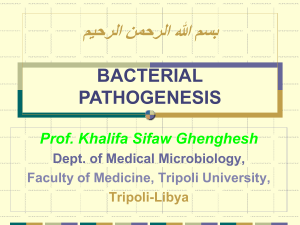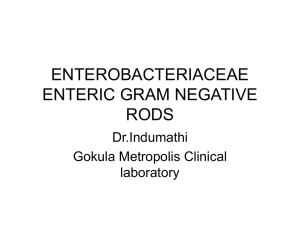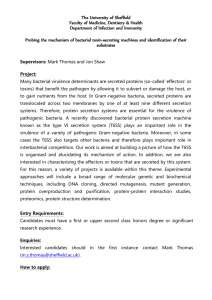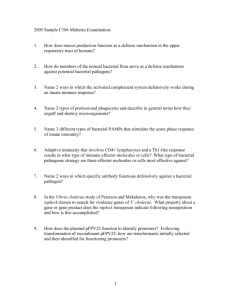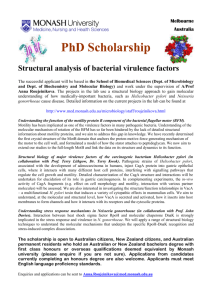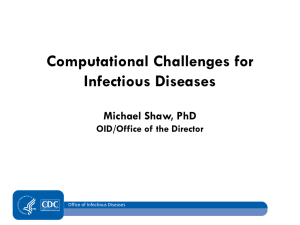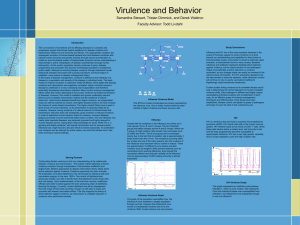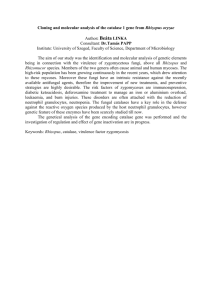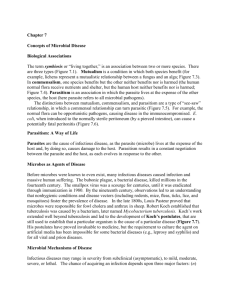The Evolution of Virulence in Bacteria and Viruses: an Opinionated
advertisement
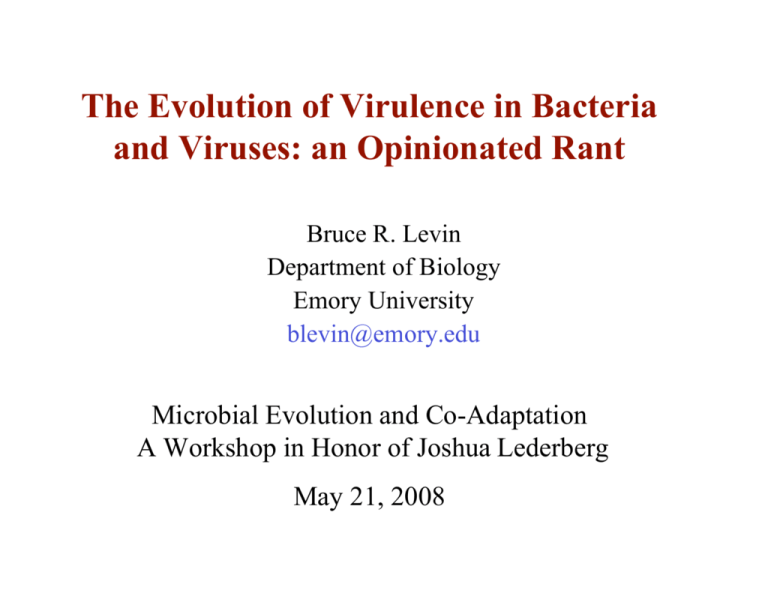
The Evolution of Virulence in Bacteria and Viruses: an Opinionated Rant Bruce R. Levin Department of Biology Emory University blevin@emory.edu Microbial Evolution and Co-Adaptation A Workshop in Honor of Joshua Lederberg May 21, 2008 Evolutionary biologists have been interested in infectious disease for a very long time. “A particle of small-pox matter, so minute as to be borne by the wind, must multiply itself many thousandfold in a person thus inoculated; and so with the contagious matter of scarlet fever1. It has recently been ascertained2 that a minute portion of the mucous discharge from an animal affected with rinderpest, if placed in the blood of a healthy ox, increases so fast that in a short space of time "the whole mass of blood, weighing many pounds, is infected, and every small particle of that blood contains enough poison to give, within less than forty-eight hours, the disease to another animal." C. Darwin The Variation in Animals and Plants Under Domestication New York: D. Appleton & Co. 1883 (The citations are to articles written in the middle 1860s.) “The Conventional Wisdom” Virulence is a primitive character for a parasite Theoretical base - A dog does not bite the hand that feeds it. Corollaries and Extrapolations (i) Evolution (coevolution) will necessarily lead to commensalism, mutualism or the extinction of the host and/or parasite. (ii) Virulence is an indication of a recent association between a parasite and its host. The conventional wisdom is an observation, not a mechanism. Why should a parasite be virulent in a novel host? Why should parasite evolution and/or parasite host co-evolution lead to commensalism? Virulence as Immunological Failings and Screw-ups, “Immunoperversity” “The pathogenicity and virulence of ________ is the product of a complex interaction between __________ and the host.” Virulence as Immunological Failings and Screw-ups, “Immunoperversity” “The pathogenicity and virulence of ________ is the product of a complex interaction between __________ and the host.” Margolis, E., and B. R. Levin, 2007 The evolution of bacteria-host interactions: virulence and the immune over-response. IN “Introduction to the Evolutionary Biology of Bacterial and Fungal Pathogens ” F.M. Baquero, A. C. Nombela, G.H. Cassel and J.A Gutteriez and Editors, ASM Press: Chapter 1, pp 3-12 Ellie Margolis Also see: Graham, A. L., J. E. Allan, and A. F. Read. 2005. Evolutionary causes and consequences of immunopathology. Annual Review of Ecology, Evolution and Systematics 36:373-397 And oodles of Stan Falkow’s papers. Immunoperversity and the Virulence of Bacteria Disease Bacteria Virulence Site (Red) Immune Perversity Damage Pneumonia S. Pneumoniae H. Influenzae N. Meningitides etc Lungs Induction of proinflammatory cytokines,edema, fibrin deposition Recruitment of fluid and cells into air spaces Duodeal Ulcers Helicobacter pylori Gastic and duodenal mucosa Chronic inflamation Mucosal atrophy Septicemic plague Yersinia pestis Circulatory system – systemic Endotoxins and other factors – systemic inflammatory response Acute shock Normally commensal Immunoperversity and the Virulence of Bacteria Disease Bacteria Virulence Site (Red) Immune Perversity Damage Rheumatic fever Streptococcus pyrogenes Heart, joints, skin and brain M-protein activation of anti-cardiac myocin antibiodies Damage to heart muscle, depositions joints & skin Tuberculosis Mycobacreria tuberculosis Lungs Persistent bacteria induce Release of high levels of TNFα Recruitment of fluid iand cells into airspaces, and tissue necrosis Meningitis S. Pneumoniae H. Influenzae N. Meningitides etc Meninges Induction of proinflammatory cytokines and chemokines Breakdown of blood-brain barrier, neutrophil recruitment intracranial pressure, brain damage Immunoperversity and the Virulence of Viruses HIV-AIDS Silvestri, G., D. L. Sodora, R. A. Koup, M. Paiardini, S. P. O'Neil et al., 2003 Nonpathogenic SIV infection of sooty mangabeys is characterized by limited bystander immunopathology despite chronic high-level viremia. Immunity 18: 441-452. Influenza Kobasa, D., S. M. Jones, K. Shinya, J. C. Kash, J. Copps et al., 2007 Aberrant innate immune response in lethal infection of macaques with the 1918 influenza virus. Nature 445: 319-323. Hypotheses for the Evolution of Virulence 1- Direct selection “Trade off” The morbidity and mortality of the infection is positively associated with the rate of horizontal (infectious) transmission of the parasite. Virulence determinants evolved in response to selection for virulence, Hypotheses for the Evolution of Virulence 1- Direct selection “Trade off” The morbidity and mortality of the infection is positively associated with the rate of horizontal (infectious) transmission of the parasite. Virulence determinants evolved in response to selection for virulence, 2- Shit happens (i) Coincidental evolution The morbidity and mortality of the infection are coincidental to the parasite’s colonization, replication and persistence in individual hosts. The virulence determinants responsible for invasive disease evolved in response to selection pressures other than virulence in that host. Hypotheses for the Evolution of Virulence 1- Direct selection “Trade off” The morbidity and mortality of the infection is positively associated with the rate of horizontal (infectious) transmission of the parasite. Virulence determinants evolved in response to selection for virulence, 2- Shit happens (i) Coincidental evolution The morbidity and mortality of the infection are coincidental to the parasite’s colonization, replication and persistence in individual hosts. The virulence determinants responsible for invasive disease evolved in response to selection pressures other than virulence in that host. 3 - Shit happens (ii) Within-host evolution Selection within the host favors mutants of normally commensal microparasites that are capable of invading and proliferating in tissues where they cause disease. The factors responsible for invasive disease evolved to their virulent state within the colonized host. 1- Direct Selection for Virulence R0 = βS (d+α+ν) Number of secondary infections generated by a single infected individual in a wholly susceptible population of density S d – rate of diseaseindependent mortlality α - rate of disease mortality ν - rate of recovery β- Rate of infectious transmission Direct Selection for Virulence Transmission (β) Number of secondary βS infections generated by a R0 = single infected individual in a (d+α+ν) wholly susceptible population of density S Virulence would evolve and be maintained if d – rate of diseasethe transmission rate parameter β is in some independent mortlality way positively associated with the virulence of the microparasite as measured by α. α - rate of disease There’s a trade-off between the need for the mortality parasite to replicate and to be infectiously ν - rate of recovery transmitted. β- Rate of infectious transmission Virulence (α) Direct Selection for Virulence: The myxoma rabbit story European rabbit (Oryctolagus cuniculus) 10 days after infection with the Standard Laboratory Strain of myxoma virus. Brazilian rabbit (Sylvilagus brasiliensis) three weeks after infection with the Standard Laboratory Strain of myxoma virus. Frank Fenner Direct Selection for Virulence: The myxoma rabbit story •Biting insect mediated transmission - need viable rabbits •Virulent - high levels of circulating virus - Rabbits that die too quickly to generate as many secondary infections as those that die more slowly • Avirulent -Low levels of circulating virus transmit the virus poorly. In accord with the direct selection for virulence (tradeoff) hypothesis, myxoma of intermediate virulence should evolve. Direct Selection for Virulence: The myxoma rabbit story Virulence (measured on laboratory rabbits) of myxoma virus strains recovered from the field in Australia expressed as percent Virulence grade Case Fatality (%) Mean survival time days 1950-51 1952-55 1955-58 1964-66 1970-74 1975-81 I >99 <13 100 13.3 0.7 0.7 0.6 1.9 II 95-99 14-16 20.0 5.3 0.3 4.6 3.3 III 70-95 17-28 53.3 54.6 63.7 74.1 67.0 IV 50-70 29-50 13.3 24.1 34.0 20.7 27.8 V <50 --0 15.5 1.3 0 0 F. Fenner (1983) Biological control, as exemplified by smallpox eradication and myxomytosis. Florey Lecture. Proc. R. Soc. Lond. B. 259-285 Number of samples 1 60 432 306 174 212 Direct Selection for Virulence While direct selection may be the most popular hypothesis for evolution and maintenance of virulence and there are other examples, save possible in the eyes of the authors of the reports, none are as compelling as the myxoma rabbit story. For a recent critique of the evidence in support of the direct selection - “trade-off” hypothesis for the evolution of virulence and its implications for “virulence management” see Ebert and Bull (2003) Trends in Microbiology 11: 15-20 Direct Selection for Virulence While direct selection may be the most popular hypothesis for evolution and maintenance of virulence and there are other examples, save possible in the eyes of the authors of the reports, none are as compelling as the myxoma rabbit story. For a recent critique of the evidence in support of the direct selection - “trade-off” hypothesis for the evolution of virulence and its implications for “virulence management” see Ebert and Bull (2003) Trends in Microbiology 11: 15-20 If virulence is due to some form of immunoperversity and is maintained by direct selection, virulent parasites must exploit that immunopervesity to their own ends. Shit-happens: (i) Coincidental evolution of virulence Criteria 1- The virulence of the infection is not positively associated with the rate of infectious transmission and may be negatively associated. 2- The morbidity and mortality of the infection can be attributed to the host’s, insufficient, inappropriate or overzealous response to the replication of the parasite and or its products (e.g. endotoxins or exotoxins). Coincidental evolution of virulence: E. coli O157:H7 Shiga toxin-encoding prophage Karyn Meltz Steinberg Roughly equal frequencies of E. coli K-12 or E. coli O157:H7 carrying and not carrying Stxencoding prophage were mixed in distilled water with Tetrahymena pyriformis from axenic cultures and the changes in density of the bacterial and protozoa populations followed respectively by plating and microscopically. Tetrahymena pyriformis. Steinberg, K. M., and B. R. Levin, 2007 Grazing protozoa and the evolution of the Escherichia coli O157:H7 Shiga toxin-encoding prophage. Proc Biol Sci 274: 1921-1929. Ratio (C600P/C600) Protozoa-Mediated Selection for E. coli carrying Shiga toxin encoding prophage With Tetrahymena Without Tetrahymena Density (Cells per ml) Total Bacteria Tetrahymena Time (days) In the presence but not absence of grazing Tetrahymena, E. coli carrying the Shiga toxin – encoding prophage have an advantage over non-lysogens Protozoa-Mediated Selection for E. coli carrying Shiga-toxin encoding prophage Naturally occurring E. coli O157:H7 with the Stx prophage also have a fitness advantage over prophage-free cells in the presence but not absence of Tetrahymena Experiments with Stx1 and Stx2 negative prophage suggest that some, but possibly not all, of the fitness advantage in the presence of Tetrahymena can be attributed to Stx2. The Stx-encoding prophage enhances survival in food vacuoles C600gfp+Prophage C600gfp Shit-happens (ii) Within-host evolution of virulence Criteria 1- The virulence of the infection is not positively associated with the rate of infectious transmission of the microparasite and may be negatively associated. 2- The morbidity and mortality of the infection requires the evolution of invasiveness of microparasite within the colonized host 3- The evolved st rain is unlikely t o be t ransmit t ed. Levin, B. R., and J. J. Bull, 1994 Short-sighted evolution and the virulence of pathogenic microorganisms. Trends Microbiol 2: 76-81. Within-host evolution of virulence A number of bacteria that are normally commensal occasionally cause invasive disease. Within-host evolution of virulence Inspirational observations Despite vast numbers of colonizing bacteria, invasive infections can be attributed to the products of very few and possibly single bacteria. Bruce Stocker Richard Moxon Meynell, G. G., 1957 The applicability of the hypothesis of independent action to fatal infections in mice given Salmonella typhimurium by mouth. J Gen Microbiol 16: 396-404. Meynell, G. G., and B. A. Stocker, 1957 Some hypotheses on the aetiology of fatal infections in partially resistant hosts and their application to mice challenged with Salmonella paratyphi-B or Salmonella typhimurium by intraperitoneal injection. J Gen Microbiol 16: 38-58. Moxon, E. R., and P. A. Murphy, 1978 Haemophilus influenzae bacteremia and meningitis resulting from survival of a single organism. Proc Natl Acad Sci U S A 75: 1534-1536. Also: Pluschke, G., A. Mercer, B. Kusecek, A. Pohl and M. Achtman, 1983 Induction of bacteremia in newborn rats by Escherichia coli K1 is correlated with only certain O (lipopolysaccharide) antigen types. Infect Immun 39: 599-608. Rubin, L. G., 1987 Bacterial colonization and infection resulting from multiplication of a single organism. Rev Infect Dis 9: 488-493. Within-host Evolution of Virulence The Moxon Murphy Experiment Blood bacteremia between 104 and 105 97% of infections were either Strs or Strr rather than mixed Mixtures of Strs and Strr H. influenzae Nasopharyngeal cultures 100< primarily Strs or Strr >105 mostly mixed CNF - 98% from monoclonal bacteremias had the same Str marker of the bacteria in the blood. Of 19 rats with mixed bacteremias 13 had monoclonal Strs or Strr infections. Moxon and Murphy PNAS 75, 1534 (1978) Within-Host Evolution of Virulence Haemophilus influenzae type b Eagan strain Sm+ and Nal+ have no discernable differences in fitness in the nasal passages, in the blood stream or in broth. Margolis and Levin. JID 2007: 196 (Oct 1): 1068-1075 Within-Host Evolution of Virulence Repeat of Moxon-Murphy Margolis and Levin. JID 2007: 196 (Oct 1): 1068-1075 Within-Host Evolution of Virulence Bacteria Invade at Random If lambda is the expected number of bacteremias then Then the distribution of rats with different numbers of invasion events (k=0,1,2): If w bacteria cross over during each invasion events then the probability of either all Nal-r or all Str-r in the blood is then: Margolis and Levin. JID 2007: 196 (Oct 1): 1068-1075 Within-Host Evolution of Virulence Only one bacterium is responsible for establishing the blood population. Margolis and Levin. JID 2007: 196 (Oct 1): 1068-1075 Within-Host Evolution of Virulence Test of the within-host evolution hypothesis Margolis and Levin. JID 2007: 196 (Oct 1): 1068-1075 Within-Host Evolution of Virulence 1/6 -Evolved- more invasive 5/6 - Unevolved - random Alas, within-host evolution is one of but not the sole explanation for the blood invasive H. influenzae being the product of single cells. Margolis and Levin. JID 2007: 196 (Oct 1): 1068-1075 Within-Host Evolution of Virulence Competition between the evolved (invasive) and ancestral strain in the nasopharynx There is no evidence for the evolved blood-invasive strain being more fit than the ancestral strain in colonizing the nasopharynx. Margolis and Levin. JID 2007: 196 (Oct 1): 1068-1075 What about the People? Co-evolution “(T)he struggle against disease and particularly infectious disease has been a a very influential evolutionary agent …” How much has infectious disease-mediated selection shaped and continues to shape J.B.S. Haldane human evolution? How do we account for immunoperversity? Haldane, J. B. S., 1949 Disease and evolution. La Ricerca Scientifica 19: 68-76. Even under the best of conditions, human evolution is slow compared to that of microbes Haploid No Dom Dominant Recessive Initial Po 0.0001 0.0001 0.0001 0.0001 Selection s 0.02 0.02 0.02 0.02 Final Pt 0.5 0.5 0.5 0.5 Generations 460.512 921.024 510.507 500360.5 Years 9.21E+03 1.84E+04 1.02E+04 1.00E+07 * Haploid No Dom Dominant Recessive Initial Po 0.001 0.001 0.001 0.001 Selection s 0.01 0.01 0.01 0.01 Final Pt 0.5 0.5 0.5 0.5 Generations 690.6755 1381.351 790.5754 100490.7 Years 1.38E+04 2.76E+04 1.58E+04 2.01E+06 * * Assumes 20 years per generation The efficacy of infectious disease-mediated selection in extant populations is not all that great The maximum intensity of selection would be the fraction of the population infected. The realized intensity of selection would depend on: • The relative numbers of progeny produced by infected and uninfected individuals. • The extent to which the variation in that number of progeny can be attributed to largely additive genetic variation. Most of the plethora of the mechanisms that protect us from bacterial and viral infections evolved long before we ascended (?) to Homo sapien and are general in their function and adaptive in their response. Direct evidence for disease-mediated natural selection in humans is not easy to come by Polymorphism The ole sickle cell story - may be aberrant • Intense selection ~ 100% infected • Childhood mortality (s~0.20) • A sick erythrocyte Rare variants Tay -Sachs, Cystic fibrosis … have been postulated to be maintained by balancing disease-mediated selection. But the selection coefficient favoring the normal homozygotes would be small s=q/(1-q) ~ 0.02 and without a specific extent disease to study it would be hard to demonstrate a disadvantage for the normal homozygotes. Inherited Variation in Infection Mortality Risk of dying of different causes between the ages of 16 and 58 for adoptees with one or more biological or adoptive parent who died of the same cause before age 50 or 70. Sorensen, T. I., G. Nielson, P. Anderson and T. Teasdale, 1988 Genetic and environmental influences on premature death in adult adoptees. New England Journal of Medicine 318: 727-732. Inherited Variation in Infection Mortality “If a biologic parent died of infection before age 50 or 70, the mortality rate for adoptees increased five fold.” Sorensen, T. I., G. Nielson, P. Anderson and T. Teasdale, 1988 Genetic and environmental influences on premature death in adult adoptees. New England Journal of Medicine 318: 727-732.

